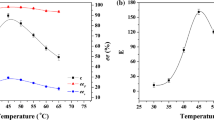Abstract
The release rate of vanillylamine from its hydrochloride salt was the limiting step in the lipase-catalysed synthesis of olvanil, a capsaicin analogue amide, in organic solvents. When the tertiary amine base concentration (N,N-diisopropylethylamine) was increased from 20 mM to 360 mM, the initial rate of amide synthesis increased proportionally. At a 12 molar excess of N,N-diisopropylethylamine and 30 min of preincubation, both the initial rate and total conversion were the same as those with free vanillylamine (80% conversion in 20 h). This result was independent of the organic solvent used. It is also shown that N,N-diisopropylethylamine does not enhance lipase activity.
Similar content being viewed by others
References
Bailen MA, Chinchilla R, Dodsworth DJ, Najera C (2000) Efficient synthesis of primary amides using 2-mercaptopyridone-1-oxidebased uronium salts. Tetrahedron Lett. 41: 9809-9813.
Baldessari A, Mangone CP (2001) One-pot biocatalyzed preparation of substituted amides as intermediates of pharmaceuticals. J. Mol. Catal. B: Enzym. 11: 335-341.
Bellot JC, Choisnard L, Castillo E, Marty A (2001) Combining solvent engineering and thermodynamic modeling to enhance selectivity during monoglyceride synthesis by lipase-catalyzed esterification. Enzyme Microb. Technol. 28: 362-369.
Campos F, Bosch MP, Guerrero A (2000) An efficient enantioselective synthesis of (R,R)-formoterol, a potent bronchodilator, using lipases. Tetrahedron Asymm. 11: 2705-2717.
Caterina MJ, Schumacher MA, Tominaga M, Rosen TA, Levine JD, Julius D (1997) The capsaicin receptor: a heat-activated ion channel in the pain pathway. Nature 389: 816-824.
deZoete MC, Kock vanDalen AC, van Rantwijk F, Sheldon RA (1996) Lipase-catalysed ammoniolysis of lipids. A facile synthesis of fatty acid amides (Erratum). J. Mol. Catal. B: Enzym. 1: 109-113.
Dray A (1992) Therapeutic potential of capsaicin-like molecules — Mechanism of action of capsaicin-like molecules on sensory neurons. Life Sci. 51: 1759-1765.
Duarte DR, Castillo E, Barzana E, Lopez-Munguia A (2000) Capsaicin hydrolysis by Candida antarctica lipase. Biotechnol. Lett. 22: 1811-1814.
Fernandez PM, Otero C (2001) Enzymatic synthesis of amide surfactants form enthanolamine. Enzyme Microb. Technol. 28: 527-536.
Gotor V (2000) Pharmaceuticals through enzymatic transesterification and enzymatic aminolysis reactions. Biocatal. Biotransform. 18: 87-103.
Govindarajan VS, Sathyanarayana MN (1991) Capsicum — Production, technology, chemistry, and quality. 5. Impact on physiology, pharmacology, nutrition, and metabolism — Structure, pungency, pain, and desensitization sequences. Crit. Rev. Food Sci. Nutr. 29: 435-474.
Han YX, Albericio F, Barany G (1997) Occurrence and minimization of cysteine racemization during stepwise solid-phase peptide synthesis. J. Org. Chem. 62: 4307-4312.
Kaga H, Miura M, Orito K (1989) A facile procedure for synthesis of capsaicin. J. Org. Chem. 54: 3477-3478.
Kobata K, Kawamura M, Toyoshima M, Tamura Y, Ogawa S, Watanabe T (1998a) Lipase-catalyzed synthesis of capsaicin analogs by amidation of vanillylamine with fatty acid derivatives. Biotechnol. Lett. 20: 451-453.
Kobata K, Toyoshima M, Kawamura M, Watanabe T (1998b) Lipase-catalyzed synthesis of capsaicin analogs using natural oils as an acyl donor. Biotechnol. Lett. 20: 781-783.
Maugard T, Remaud Simeon M, Petre D, Monsan P (1997) Enzymatic synthesis of glycamide surfactants by amidification reaction. Tetrahedron 53: 5185-5194.
Orain D, Ellard J, Bradley M (2002) Protecting groups in solidphase organic synthesis. J. Comb. Chem. 4: 1-16.
Parker MC, Brown SA, Robertson L, Turner NJ (1998) Enhancement of Candida antarctica lipase B enantioselectivity and activity in organic solvents. Chem. Commun. 2247-2248.
Plou FJ, Cruces MA, Ferrer M, Fuentes G, Pastor E, Bernabe M, Christensen M, Comelles F, Parra JL, Ballesteros A (2002) Enzymatic acylation of di-and trisaccharides with fatty acids: choosing the appropriate enzyme, support and solvent. J. Biotechnol. 96: 55-66.
Szallasi A, Blumberg PM (1996) Vanilloid receptors: new insights enhance potential as a therapeutic target. Pain 68: 195-208.
Theil F (2000) Enhancement of selectivity and reactivity of lipases by additives. Tetrahedron 56: 2905-2919.
Author information
Authors and Affiliations
Rights and permissions
About this article
Cite this article
Reyes-Duarte, D., Castillo, E., Martínez, R. et al. Lipase-catalysed synthesis of olvanil in organic solvents. Biotechnology Letters 24, 2057–2061 (2002). https://doi.org/10.1023/A:1021371422062
Issue Date:
DOI: https://doi.org/10.1023/A:1021371422062




